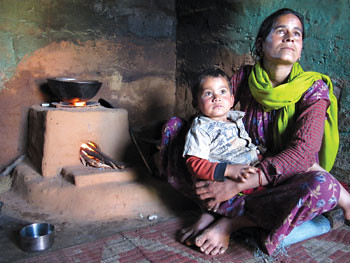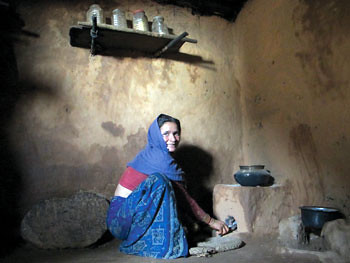A cheap and simple stove promises to transform the lives of rural Nepali families

PICS: KUNDA DIXIT
The stove has changed our lives. We save money and time and will probably live longer. "Gauri Devi Bhatt, 35"
Urban Nepal is pre-occupied with power cuts, even though only 1.5 per cent of the country’s
energy need is from electricity. There are protests every time fuel prices are raised, yet only eight per cent of Nepalis use diesel, kerosene or LPG for cooking.
Over 80 per cent of Nepal’s population, mostly women, cook on firewood, straw or dried dung. A clean and cheap new chulo could transform the lives of 20 million rural Nepalis, yet it was difficult to get anyone excited about it.
That is changing. As one of its last acts, the Baburam Bhattarai government set a target to make all Nepali homes smokeless by 2017. Improved cooking stoves use less than half the firewood compared to open hearth fireplaces, they cook faster, and are nearly smokeless.
“You should have brought this chulo when I was young, it would have made my life a lot easier,” rues 40-year-old Yasodha Tamrakar in Domada village. “I spent all my life carrying firewood from the forest, washing blackened pots, my eyes would always be itchy and red, the children would cough all the time.”
Less than a year after a campaign to introduce the new stoves was launched in Domada, nearly all the 115 households have installed the new fireplace, called the ‘Rocket’. Demonstration effect is increasing demand for the stoves in neighbouring VDCs. Dadeldhura and Doti are on track to meet the 2017 target.
Nearly one million households in Nepal are already smokeless because of the spread of improved stoves and biogas and there are 3.5 million to go. Govind Pokharel at the Alternative Energy Promotion Centre (AEPC) in Kathmandu believes it is possible to eliminate indoor air pollution in the next four years.
“We are already installing 250,000 smokeless chulos a year in 33 districts, so we just need to scale up and entrust NGOs with delivery,” Pokharel told us, “Nepal is not poor, we are just poor in coordinating and conceptualising.”

I used to spend 6 hours and carry 50kg of firewood on my back every day, now I go once a week and carry smaller loads. "Yasodha Tamrakar, 40"
Pokharel is clearly a man with a mission. He became a strong advocate for improved stoves when, as a 14-year-old in Piuthan who did his homework by an oil lamp, he couldn’t bear to see his mother suffer chronic eye and lung infections because of exposure to smoke from the kitchen fire.
“I knew we had to get the smoke out somehow, so I made a hole in the roof and installed a chimney,” he recalls. Now, as a mechanical engineer with a degree from Germany in renewable energy, Pokharel is committed to make every Nepali household smokeless.
To meet the 2017 deadline, the government has parcelled out improved cooking stove promotion to the Dutch aid group, SNV, Worldwide Fund for Nature, and the World Conservation Union. Because the needs vary, different models of smokeless fuel-efficient stoves are being promoted in the plains, hills, and mountains. In higher regions, for example, stoves need to also provide hot water and space heating, in the hot plains kitchens need to have cross ventilation.
“The Rocket’s beauty is that it not only reduces drudgery for women and improves health, but also cuts emission of greenhouse gases and black carbon, and Nepal can reap cash benefits from the Clean Development Mechanism which can be ploughed back into the community,” says Tek Balayar of the Doti-based Rural Development Service Centre.
Every year, 7,500 Nepali children die of pneumonia and respiratory tract infections mainly caused by indoor smoke. This, as well as incidence of asthma and eye infections, could be significantly reduced if the 2017 target is met. In addition, AEPC estimates that Nepal could save 10 million tons of firewood annually with the fuel-efficient stoves.
Saroj Rai, who promotes improved cooking stoves for SNV in the far-west, says it’s a question of priority. “The government spends billions subsidising LPG for urban dwellers,” he told Nepali Times, “but here is a technology that will make a far bigger impact on public health and women’s welfare in rural areas. And there is reluctance to support it.”
10 PLUS POINTS
Compared to traditional chulos, the Rocket:
1.Reduces firewood use by half
2.Reduces cooking time by half
3.Doesn’t need thick logs
4.Eliminates indoor smoke
5.Reduces lung and eye infections
6.Easier to clean pots and clothes
7.Saves time and reduces drudgery for women
8.Lighter firewood load = less risk of prolapsed uterus
9.Reduces infant mortality
10.Stoves stay hot even after fire dies out
Rocket technology
The metal core of the Rocket (right) can be crafted in rural workshops to be embedded in insulation and a traditional clay plaster of Nepali kitchens (left). It makes existing hearths more efficient by increasing airflow and allowing intense combustion so there is more heat and less smoke. First designed in Latin America in 1982, the Rocket has twice won the Ashden Award and is so named because of the roar and intense heat of the fire.